
Original Link: https://www.anandtech.com/show/2135
AMD's 65nm Brisbane Core Previewed: The most energy efficient AMD CPU to date
by Anand Lal Shimpi on December 14, 2006 6:08 PM EST- Posted in
- CPUs
When Intel launched its Core 2 line of processors we saw AMD's performance and power advantages vanish into thin air but the comparison, at least on the power side, wasn't totally fair. Intel had been shipping desktop processors on its 65nm process for months prior to the launch of Core 2, while AMD's Athlon 64 X2s were still built on a 90nm process. We had no way of telling how much of Intel's power advantage was due to a more efficient architecture or simply smaller, cooler running transistors. Up to now, AMD has been penalized twice in all Core 2 vs. Athlon 64 X2 comparisons; AMD's new micro-architecture won't debut until next year and neither will 65nm in any great quantities.
Technically in-line with roadmaps, AMD just introduced and announced shipment of its first 65nm cores: codenamed Brisbane. Availability is another story entirely, as it's looking like we won't see any real quantities of these things until Q1 2007. Right now AMD's Brisbane chips are strictly OEM only and AMD wasn't able to give us an indication of when to expect retail/channel availability. Of course we wouldn't be talking about this today if we didn't have a chip, which we do, but for all intents and purposes you can consider this a preview of what to expect in the new year from AMD's first 65nm chips.
AMD announced its Brisbane lineup earlier this month, the chips and basic specs are listed below:
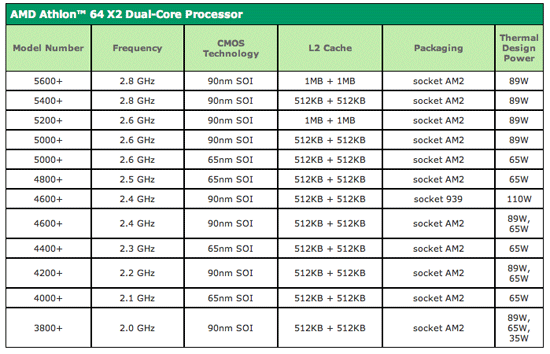
As you can expect, AMD is pricing the 65nm chips in line with its 90nm offerings to encourage the transition. Die size and TDP have both gone down to 126 mm^2 and 65W across the line. As AMD improves its 65nm SOI process you can expect to see even lower wattage parts, but for now all of the 65nm chips are rated at 65W TDP.
Transistor count remains unchanged at 154M as there is no new functionality or cache introduced with the move to 65nm. Once again, we will have to wait until around the middle of 2007 before we'll see any major changes to AMD's architecture.

The chip we received was AMD's 65nm Athlon 64 X2 5000+ and from the outside, it looks just like a normal X2. The only way to tell that this is a 65nm chip is by looking at the OPN.
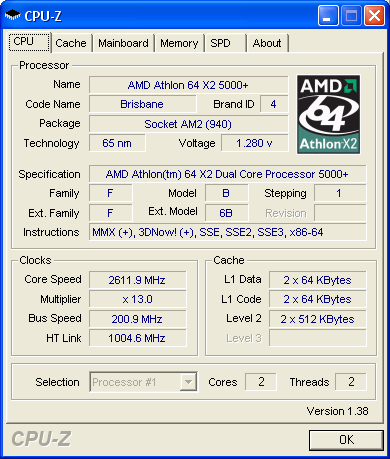
Armed with the chip and its $301 price point we set out to compare its performance, power consumption and power efficiency to AMD's other 90nm CPUs and the closest price competitor from Intel: the Core 2 Duo E6600 priced at $316.
The Test
Performance-wise, the new Brisbane chips shouldn't be any different than their 90nm counterparts, but to make sure we benchmarked the new chip against our first 90nm X2 5000+. From a power consumption standpoint, we wanted to compare the new 65W 65nm chip to AMD's Energy Efficient and Energy Efficient Small Form Factor 90nm chips to see how the new process competes with the most efficient of AMD's CPUs that use the older, but more mature process. Unfortunately, we only have a 5000+ 65nm chip, so we can't say for certain what advantages Brisbane will hold at equivalent clocks to the EE/SFF parts.
For each benchmark we measured performance as well as average power consumption during the course of the benchmark, finally reporting performance per watt as one divided by the other.
| CPU: | Intel Core 2 Duo E6600 (2.40GHz/4MB) AMD Athlon 64 X2 5000+ (2.6GHz/512KBx2) AMD Athlon 64 X2 5000+ "Brisbane" AMD Athlon 64 X2 EE 4600+ (2.4GHz/512KBx2) AMD Athlon 64 X2 EE SFF 3800+ (2.0GHz/512KBx2) |
| Motherboard: | eVGA NVIDIA nForce 680i ASUS M2N32-SLI Deluxe |
| Chipset: | nForce 680i nForce 590 SLI |
| Chipset Drivers: | NVIDIA 9.53 NVIDIA 9.35 |
| Hard Disk: | Seagate 7200.9 300GB SATA |
| Memory: | Corsair XMS2 DDR2-800 4-4-4-12 (1GB x 2) |
| Video Card: | NVIDIA GeForce 8800 GTX |
| Video Drivers: | NVIDIA ForceWare 97.44 |
| Resolution: | 1600 x 1200 |
| OS: | Windows XP Professional SP2 |
Before we get to the power consumption tests let's have a quick look at idle power consumption of these systems:

Note that Cool 'n Quiet and EIST were enabled for all tests, but running at 1GHz the AMD CPUs at idle are able to draw much less power than the Intel system (which runs at an idle clock speed of 1.6GHz). Part of the increased power consumption for the E6600 may also be due to the 680i chipset vs. the 590 SLI used on the AMD systems, but we would need to compare both chipsets on a common CPU platform to be sure of that.
Regardless of the reasons, at idle, our Intel test platform consumes much more power than any of the AMD platforms. At the same time, the new 65nm Brisbane CPU doesn't really draw significantly less power than the 90nm cores at idle. Under load though, we've got a completely different story...
Media Encoding Performance & Power Consumption
In the interest of time we skipped our general application suites (SYSMark/Winstone) and dove directly into the individual application benchmarks to give us a more direct idea of how AMD's new 65nm chips will fare. We start off with our Windows Media Encoder test:

At the same price point, Intel is still faster with the E6600 as we've seen in the past, but what we're here mainly to do is to compare power usage, so let's see how Brisbane stacks up.
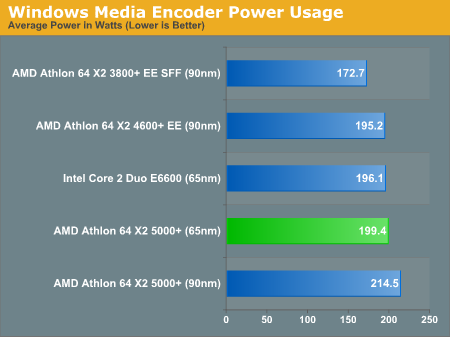
Power consumption is down from 90nm, as the 65nm system used about 15 fewer watts than its predecessor. The move to 65nm actually brings AMD in line with the power consumption of Intel's Core 2 Duo E6600, but it is still not enough to best the EE and EE SFF chips, the latter of which is rated at a cool 35W TDP.

Performance per watt is a different story; although AMD can compete with Intel in terms of power usage, it will take a new architecture to close the performance gap and thus performance per watt suffers in comparison to Core 2 Duo. The good news is that if we just look at the AMD CPUs in the performance per watt chart, it looks like the new 65nm processor offers better performance per watt than anything else in AMD's lineup - even the EE/EE SFF CPUs.
Moving on to our DivX test we see more of the same: the performance lead clearly goes to Intel's Core 2 Duo E6600:
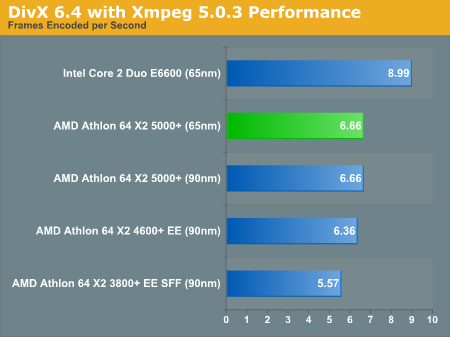
Power usage is actually slightly lower on the 65nm AMD system than on the Core 2 Duo platform, and a bit lower than the 90nm X2 5000+ setup. The difference between 90nm and 65nm isn't huge here, a matter of just under 10W, but hopefully it's merely a sign of an early 65nm process compared to a more mature 90nm process.
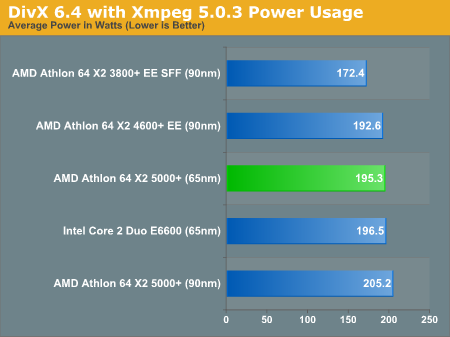
The performance per watt crown still belongs to Intel, but if you look at AMD alone, Brisbane offers better efficiency than anything else in AMD's lineup.
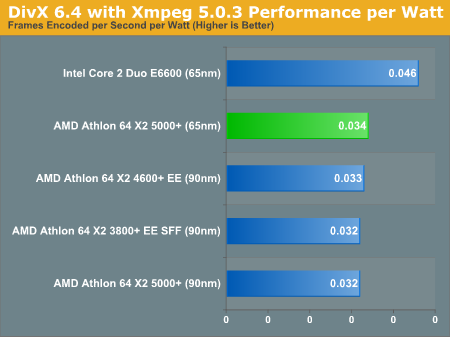
Media Encoding Performance & Power Consumption - Continued
Our final two encoding tests are, as always, Quicktime for testing H.264 encode performance and iTunes for testing multi-threaded MP3 encode performance.
Quicktime paints the same picture we've seen with WME and DivX, so there are no surprises here:
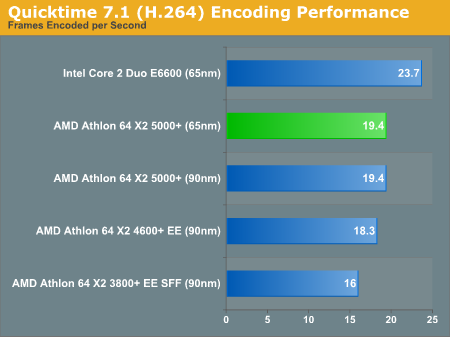
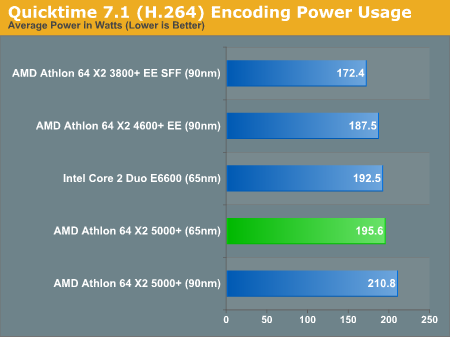
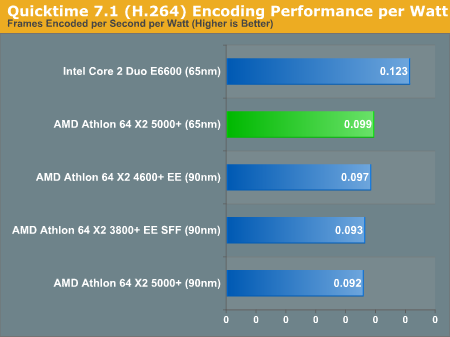
Rounding out our encoding tests we have similar standings with our iTunes performance test:

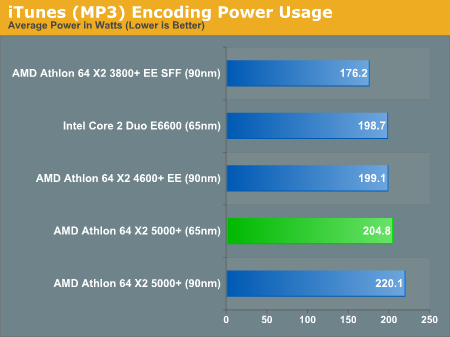
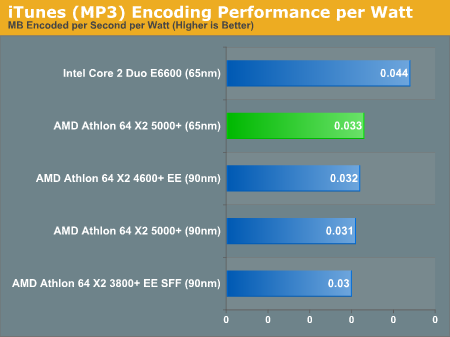
Power consumption is a bit lower on 65nm, but Intel still has a bit of a power advantage here with the E6600.
Performance per watt of course goes to Intel, not necessarily due to advantages in power consumption but rather the inherent performance advantage of the Core architecture.
3D Rendering Performance & Power Usage
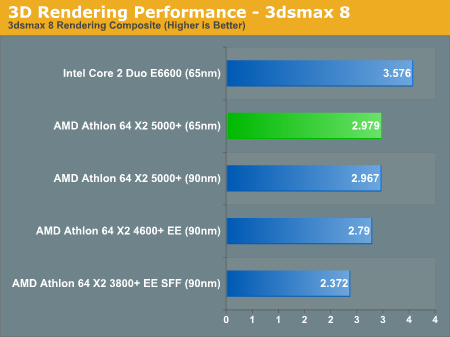
Looking at 3D rendering performance, Intel's Core 2 Duo still comes out on top in performance, but once again our focus this time around is on power consumption, so let's have a look at that.
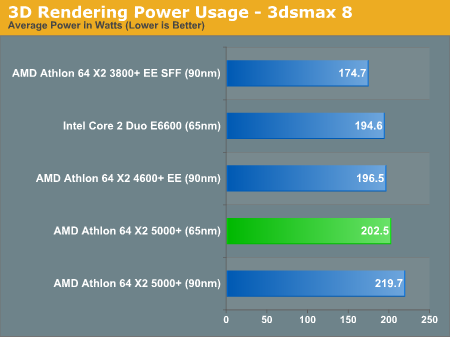
There's a noticeable reduction in total system power consumption with the move to 65nm, but AMD's EE/EE SFF and Intel's Core 2 processors all draw less power than the new 5000+.
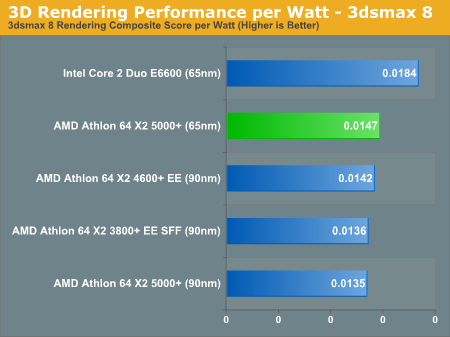
Looking at efficiency however, Brisbane is the best AMD has got to offer. It is still no where near the performance per watt you can get with Intel these days, but it's a step in the right direction. If AMD's updated micro-architecture can narrow the performance gap next year, we may see some competition in the performance and performance per watt space once again.
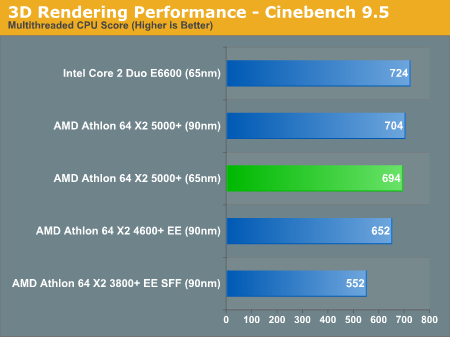
The performance under Cinebench is far closer between the E6600 and the X2 5000+, with the slight nod going to the Core 2 CPU.
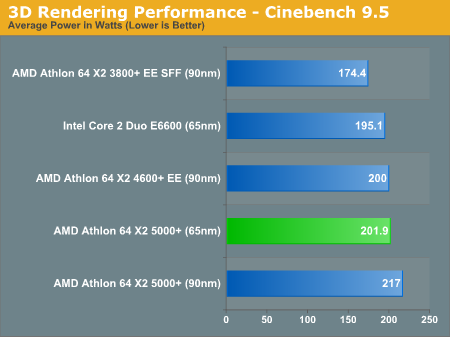
Power consumption is also relatively close between the two CPUs, with Intel once again coming in a bit lower at 195.1W. The move from 90nm to 65nm shaves off about 15W of total system power consumption, which isn't bad given that there's no change in processor pricing.
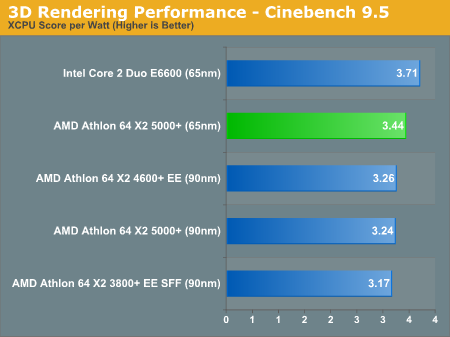
Performance per watt is close between Intel and AMD, closer than in any of our other tests, but Intel ends up with the overall win. Looking just at AMD CPUs, the Brisbane core continues to offer better performance per watt than even the most efficient 90nm X2s AMD had previously offered.
Gaming Performance & Power Usage
By and large the biggest contributor to power consumption when running 3D games is going to be your graphics card, and in this case it's the 8800 GTX plugged into our test bed. That being said, there is still a fairly sizable difference between the CPUs in power consumption; we're simply dealing with much higher numbers than before thanks to the GPU running at full load.
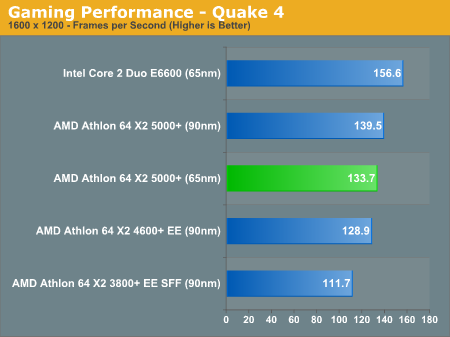
Core 2 is significantly faster than the X2 in Quake 4, which we've seen in previous comparisons. We ran into a strange anomaly with gaming performance and our Brisbane chip; for some reason, in Quake 4 and Half Life 2, the 65nm 5000+ ended up being slightly slower than its 90nm counterpart. We're still waiting for an answer from AMD, but as far as we know there shouldn't be any performance differences between the two chips.
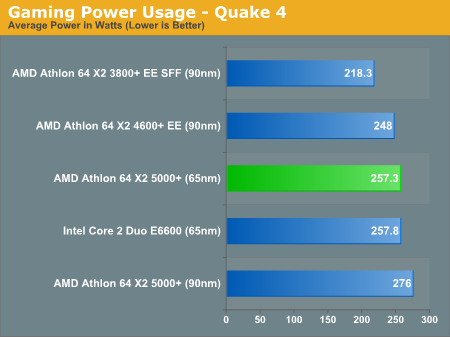
Power consumption is basically equal between the Brisbane 5000+ and the Core 2 Duo E6600, but given that the latter performs so much better Intel gets the overall win in power efficiency:

Switching games doesn't change the rankings at all, as Oblivion gives us a repeat of what we saw in Quake 4. Interestingly enough, we didn't see a performance difference between the 90nm and 65nm 5000+ offerings here like we did in Quake 4.
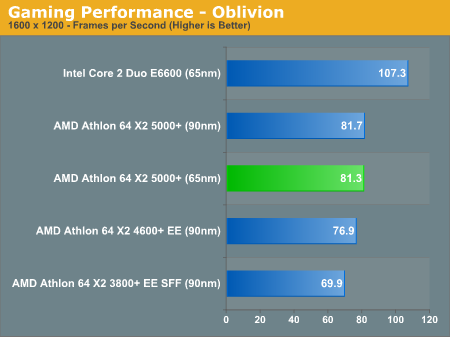
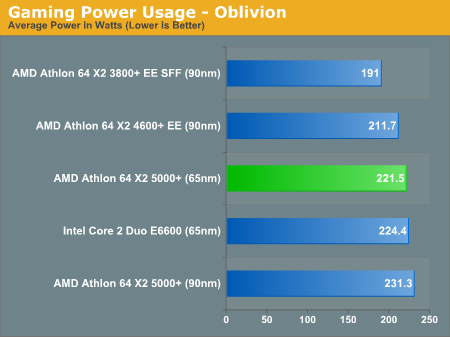
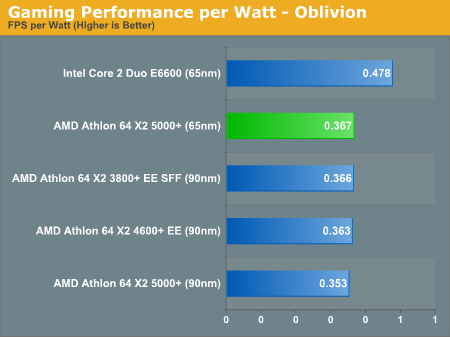
Gaming Performance & Power Usage - Continued
Our final gaming test is Half Life 2: Episode One, which provides us with another example of slightly lower performance of the new 65nm chip. The difference is less than 5%, so it could just be an unusually high variation between chips. If it isn't an issue with the benchmark then it could be a CPU problem, expected behavior, a BIOS tweak, or an issue with our test platform itself. Rest assured that as soon as we know more we will report it.
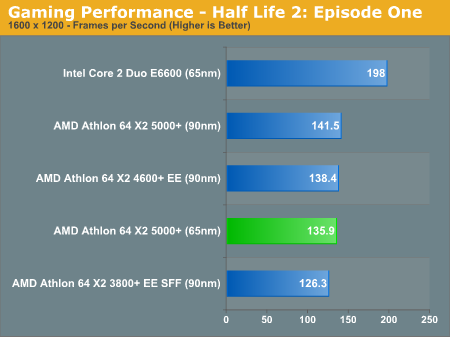
Power consumption under Half Life 2: Episode One is actually very good for the X2 5000+, due in part to its lower performance compared to the other AMD/Intel CPUs. The Core 2 Duo E6600 actually consumes the most power here, as it is also feeding the GPU the fastest out of all of the contenders. The higher performance still keeps it in the lead in terms of performance per watt, however.
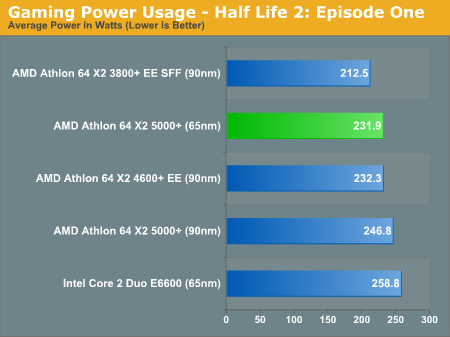
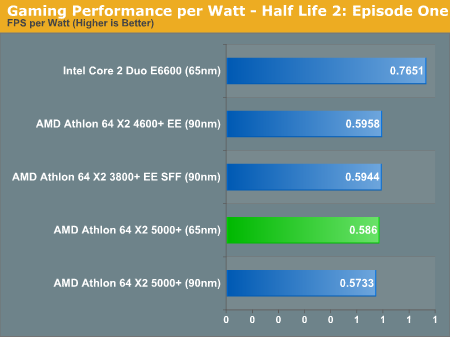
Temperature, Overclocking and Final Words
Lower power consumption and cooler operation are both positive side effects of AMD's new 65nm process, the latter of which is exemplified by the graph below:
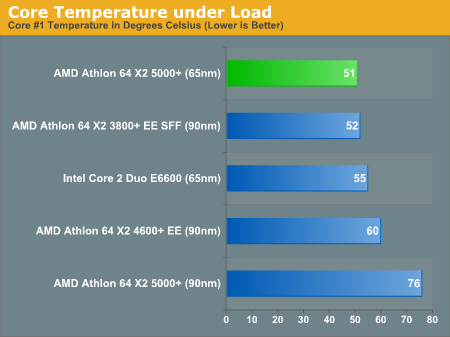
What we're looking at here is the core temperature of the 2nd core in all of the CPUs, under full load, as reported by Core Temp. While it's not necessarily useful (or accurate) to compare readings across two different motherboards, as is the case when looking at AMD vs. Intel, the comparisons between AMD chips alone are enough to showcase the reduction in temperature.
With both cores under load for 15 minutes (calculating Fast Fourier Transforms) the 65nm 5000+ manages to produce just about as much heat as the X2 3800+ EE SFF. While this won't always be the case, it gives you an idea of the reduction in temperatures you can expect from AMD's new 65nm chips.
What about overclockability? We were unfortunately not able to get that much more out of the new 65nm core as we could from mature 90nm chips. Our X2 5000+ was able to run at 2.925GHz, at 1.475V with stock air cooling. If equipped with better air cooling or something more exotic, reaching over 3GHz shouldn't be a problem, but we wouldn't expect to see anything too far over 3GHz.

Overall we're left with mixed feelings after playing with AMD's first 65nm chips. Power consumption is definitely reduced compared to its 90nm offerings; in our tests we saw an average reduction in total system power consumption of 14.6W thanks to the new Brisbane core. Along with the lower power draw comes lower temperatures, which is also good. For no additional cost, and given that it should help alleviate AMD's capacity constraints thanks to a smaller die, there's nothing to complain about on that front.
However we would like to see more, and we have a feeling that it may end up being the 2nd rev of 65nm CPUs from AMD that truly interest us. Just as we saw with AMD's 90nm cores, it wouldn't be too surprising to see lower TDP parts emerge as AMD's process matures. We do hope to see an Energy Efficient line of X2s built on AMD's 65nm process, although it may take some time for AMD's manufacturing to reach the point where it can offer significantly reduced TDP 65nm parts.
The tweaks and advancements that AMD can do to make its 65nm parts more attractive can only go so far; while they will boast lower power consumption and improve production numbers for AMD, what we really need is a long overdue update to the K8 architecture. AMD has already promised it and we're expecting big things by the middle of next year, but in the mean time at least things will be a little cooler on the green side.







